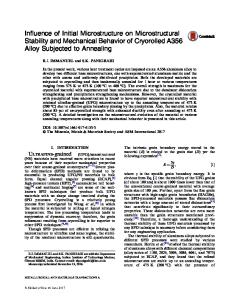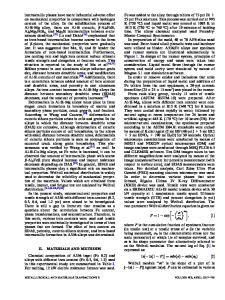Effect of Ni on Microstructure and Creep Behavior of A356 Aluminum Alloy
- PDF / 2,481,013 Bytes
- 10 Pages / 595.276 x 790.866 pts Page_size
- 14 Downloads / 397 Views
Effect of Ni on Microstructure and Creep Behavior of A356 Aluminum Alloy Mohammad Varmazyar1 · Shahrouz Yousefzadeh1 · Sheikhi Mohammad Morad1,2 Received: 2 August 2020 / Accepted: 29 September 2020 © The Korean Institute of Metals and Materials 2020
Abstract The effect of 0.25, 0.5 and 1 wt% Ni addition on the impression creep behavior of the cast A356 alloy was investigated. Optical and scanning electron microscopy (SEM) equipped with energy dispersive spectrometry (EDS) were used for examination of the microstructure. The alloy’s creep properties were investigated using the impression creep technique under normalized stress of 0.022–0.03 (corresponding to 600–675 MPa) and temperature of 473–513 K. The results showed that the creep properties of A356 alloy were improved by the addition of Ni. The improved creep properties were attributed to the modification of eutectic silicon and the formation of Ni-rich intermetallics. Calculating the values of stress exponent (n) and creep activation energy (Q) indicated that the dominant mechanism was the lattice self-diffusion climb controlled and Ni had no effect on the creep mechanism. Keywords A356 alloy · Nickel · Microstructure · Creep properties · Creep mechanism
1 Introduction Among the commercial aluminum casting alloys, the siliconcontaining alloys are very favorable for automotive and aerospace industries due to their excellent casting characteristics. A356 alloy (Al–7Si–0.3 Mg) is one of the most conventional aluminum casting alloys with excellent casting capability, good corrosion/wear resistance and desirable mechanical properties [1, 2]. An example of using the alloy in engine manufacturing is cylinder heads with operating temperature range of 473–523 K [3, 4]. However, due to microstructural instabilities at high temperatures, the mechanical properties of this alloy are lost and its application is limited to temperatures below 423 K [4]. Therefore, in recent years, many efforts have been made to improve the mechanical properties and modify the microstructure of this alloy [5–9]. In order to improve the creep properties of A356 alloy, Wang et al. [5] suggested the addition of copper with small quantities of zirconium and vanadium. The improvement * Shahrouz Yousefzadeh [email protected] 1
Department of Mechanical Engineering, Aligudarz branch, Islamic Azad University, Aligudarz 68618‑85914, Iran
Faculty of Mechanical Engineering, Shahid Rajaee Teacher Training University, Tehran 16788‑15811, Iran
2
of creep properties is attributed to fine and semi-coherent particles with high thermal stability rich in zirconium and vanadium. In another research, with the addition of small quantities of elements such as V, Zr, Ti and Mn as well as considerable amounts of Cu to Al7SiMg alloy, Garat [6] studied the high temperature behavior of this alloy. The hot tensile strength and creep properties of the alloy proposed in the temperature range of 523–573 K was considerable compared to the base alloys and this alloy is introduced for the components of
Data Loading...










